SCANNING THE PAST: A HISTORY OF ELECTRICAL ENGINEERING FROM THE PAST
Submitted by Marc Bell, Editor
Copyright 1997 IEEE. Reprinted with permission from the IEEE publication, “Scanning the Past” which covers a reprint of an article appearing in the Proceedings of the IEEE Vol. 85, No. 11, November 1997.
Edward W. Herold: A Leader in the Development of Color Television
Sixty years ago this month, the proceedings of the institute of radio engineers (IRE) included a paper by Edward W. Herold (Fig. 1) on an application of negative resistance in vacuum-tube circuits. At the time, he was a research engineer at the Radio Corporation of America (RCA), where he worked for approximately 36 years. He received the IEEE Founder’s Medal in 1976 as recognition for his outstanding contributions to the electrical engineering profession, including his leadership in the development of the shadow-mask 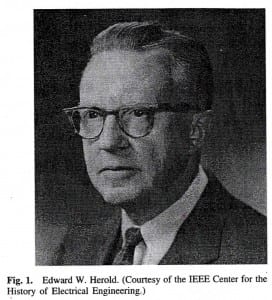 picture tube for color television.
picture tube for color television.
Herold was born in New York City in 1907, and developed an early interest in amateur radio. He worked as a technical assistant in the Engineering Department of the Western Electric Company in 1924-1925, and at the Bell Telephone Laboratories in 1925-1926. Early in 1927, he became a vacuum-tube tester at the E. T. Cunningham Company, known for the high quality of its electronic tubes, and he continued to work there during summer vacations as an undergraduate. He received the degree in physics from the University of Virginia in 1930 and the M.S. degree from the Polytechnic Institute of Brooklyn in 1942.
Herold joined an advanced development group at the Radiotron subsidiary of RCA in July 1930, where his group was responsible for the development of new types of vacuum tubes suitable for radio applications. One of his first projects was an investigation of secondary emission in screen-grid tubes (tetrodes), and his first patent application, filed in 1932, concerned a method to suppress secondary emission (Fig. 2). This invention was utilized in the Type 48 power tetrode, and the related research was reported in his first IRE paper, published in the October 1935 proceedings, on the subject of “negative resistance and devices for obtaining it.” During the 1930’s, he also contributed to improvements and applications of pentode power amplifiers and the pentagrid converter tube. He also worked on wide-band amplifiers suitable for television receivers and designed and built a home television receiver in time to pick up broadcasts originating at the 1939 World’s Fair. He published a paper in 1940 in the RCA Review on converters for television receivers.
Herold joined the newly established RCA Laboratories in Princeton, NJ, in 1942. He published a comprehensive IRE paper on frequency converters and mixers in February
1942 and was coauthor with L. Malter of a series of IRE papers on radio reception at ultrahigh frequencies, published during 1943. Herold was elected a fellow of the IRE in 1948 for his contributions to the theory and design of vacuum tubes.
By 1949, it became evident to proponents of color television that a critical problem was the lack of a color picture tube suitable for compatibility with existing black-and-white television. Consequently, top management at RCA decided in September 1949 to launch a crash program involving several teams to attempt to produce a solution to the problem. Herold was given overall responsibility for organizing and directing the company-wide effort. One of the RCA researchers, H. B. Law, made a key invention involving a photolithographic technique that enabled fabrication of the so-called shadow-mask picture tube. RCA gave a public demonstration of a prototype shadow-mask tube in March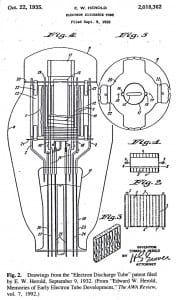 1950 and began manufacture of the tubes in 1951.
1950 and began manufacture of the tubes in 1951.
A special theme issue of the proceedings of the IRE published in October 1951 featured 11 papers by RCA participants in the crash research program. 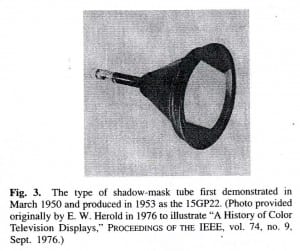 Included were Law’s paper, “A Three-Gun Shadow-Mask Color
Included were Law’s paper, “A Three-Gun Shadow-Mask Color
Kinescope,” and Herold’s paper, “Methods Suitable for Television Color Kinescopes.” In a retrospective article on the history of color television displays published in the proceedings of the IEEE in September 1976, Herold characterized the shadow-mask color tube as “one of the most dramatic and important developments of the past quarter century.” (See Figs. 3-5.)
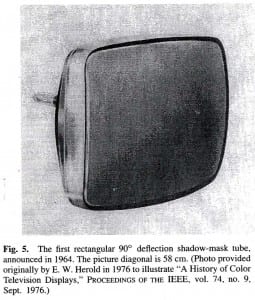 Herold left RCA in 1959 to become a vice president of research at Varian Associates in Palo Alto, CA. He returned to RCA in 1965, where he was director of technology at the David Sarnoff Research Laboratories until his retirement in 1972. Following his retirement, he engaged in private consulting and served as chairman of the board of the Palisades Institute for Research Services. He also served as chairman of an IEEE planning committee assigned to identify areas neglected by the IEEE and served on the Editorial Board of
Herold left RCA in 1959 to become a vice president of research at Varian Associates in Palo Alto, CA. He returned to RCA in 1965, where he was director of technology at the David Sarnoff Research Laboratories until his retirement in 1972. Following his retirement, he engaged in private consulting and served as chairman of the board of the Palisades Institute for Research Services. He also served as chairman of an IEEE planning committee assigned to identify areas neglected by the IEEE and served on the Editorial Board of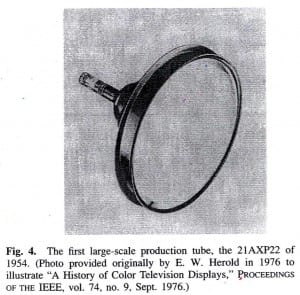 IEEE SPECTRUM. He exhibited an avid interest in electrical engineering history and served on the IEEE History Committee for several years in the 1980’s. He died in June 1993 at age 85.
IEEE SPECTRUM. He exhibited an avid interest in electrical engineering history and served on the IEEE History Committee for several years in the 1980’s. He died in June 1993 at age 85.
James E. Brittain
PROCEEDINGS OF THE IEEE, VOL. 85, NO. 11, NOVEMBER 1997
